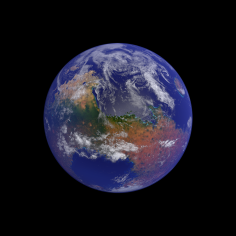SHI WEILI
SHI WEILI

source:shi-weilicom
Ever since humankind was able to look back to Earth from space, the view of the “blue planet” seems to provoke a contemporary type of nostalgia and inspire poetic reflection. Images of Mars could arouse quite the opposite—the feeling of otherness, the realization of our loneliness in the universe. What I present here is planet Mars in a visual style that resembles our own planet. For this project, I have trained an artificial neural network with topographical data and satellite imagery of Earth so that it can learn the relation between them. The trained model was then applied to topographical data of Mars to generate images that resemble satellite imagery of Earth. Terra Mars suggests a new approach to creative applications of artificial intelligence—using its capability of remapping to broaden the domain of artistic imagination.
The conditional generative adversarial nets (Conditional GAN) model and data examples used in the project. Earth data was used in the training phase, while Mars data was used in the generation phase. The generator was trained to produce color images according to topographical data in hopes of convincing the discriminator which was trained to be knowledgeable about the authenticity of Earth imagery. The two networks were trained in turn so that they can compete and grow together. The datasets consist of global data of Earth and Mars sliced into thousands of tiles. To facilitate training and generation, land-ocean mask, longitude, and latitude data were also used.
The generated global texture is extra high-resolution—consists of nearly a billion pixels, it enables gallery-quality rendering of the generated Mars as a globe, as a detailed map, and even as close-ups that the audience can dive into.
ou are welcomed to interpret Terra Mars from various perspectives. You can enjoy it as a playful remix of the two planets, or you can relate this imaginary version to the astronomical facts of the Red Planet. Maybe you consider it as a preview of a possible outcome of human’s terraforming efforts, or you just appreciate the sheer beauty of a planet that resembles our own.
To me, the most intriguing aspect of this AI-based creative approach is the seemingly contradicting assessments we can make of the generated Mars imagery—based on the astronomical facts of Mars, the generated look of it is by no means scientific, but on the other hand, it is created by inferring solid logic learned from precise data by a meticulous and tireless artificial intelligence. The AI has learned every corner of the Earth terrain for hundreds of times and applied its knowledge to every decision during its generation of the Martian terrain. This is not an approach that can be carried out by a human artist alone.
Therefore, I would like to claim that AI is the new imagination. Its unique capabilities such as remapping between domains should inspire and support artists to create artworks that the world has never seen.
.
.
.
.
.
.
.
source:creativeapplicationsnet
Created by SHI Weili, For this project, Terra Mars is a speculative visualisation by an ANN (artificial neural network) to generate images that resemble satellite imagery of Earth modelled on topographical data of Mars. Terra Mars suggests a new approach to creative applications of artificial intelligence—using its capability of remapping to broaden the domain of artistic imagination.
For this project, SHI trained a conditional generative adversarial nets (Conditional GAN) model with topographical data and satellite imagery of Earth so that it can learn the relation between them. A GAN consists of two neural networks—the generator and the discriminator. The generator was trained to produce color images according to topographical data in hopes of convincing the discriminator which was trained to be knowledgeable about the authenticity of Earth imagery. The two networks were trained in turn so that they can compete and grow together. The datasets consist of global data of Earth and Mars sliced into tiles. Earth data was used in the training phase, while Mars data was used in the generation phase.
SHI welcomes different interpretations of Terra Mars. It can be enjoyed simply as a playful remix of the two planets, or one can relate this imaginary version to the astronomical facts. Maybe one can even consider this as a preview of a possible outcome of human’s terraforming efforts, or you just appreciate the sheer beauty of a planet that resembles our own.
.
.
.
.
.
.
.
source:wiucloudnet
由SHI Weili创建,对于这个项目,Terra Mars是一个人工神经网络(人工神经网络)的投机可视化,可以生成类似于地球卫星图像的图像,模仿火星的地形数据。Terra Mars提出了一种创新应用人工智能的新方法 – 利用其重新映射的能力拓宽艺术想象的领域。
“自从人类能够从太空回望地球以来,”蓝色星球“的视角似乎引发了当代的怀旧情绪并激发了诗意的反思。
火星的图像可以引起相反的反面 – 异性的感觉,我们在宇宙中的孤独感的实现。
我在这里展示的是火星,它的视觉风格类似于我们自己的星球。”
对于这个项目,SHI训练了一个带有地形数据和地球卫星图像的条件生成对抗网(Conditional GAN)模型,以便它可以学习它们之间的关系。GAN由两个神经网络组成 – 发生器和鉴别器。对发生器进行了训练,根据地形数据生成彩色图像,希望说服训练有素的鉴别者了解地球图像的真实性。这两个网络依次接受培训,以便他们可以一起竞争和共同成长。数据集由切割成瓷砖的地球和火星的全球数据组成。地球数据用于训练阶段,而火星数据用于生成阶段。
对我而言,这种基于人工智能的创作方法最有趣的方面是我们可以对生成的火星图像进行看似矛盾的评估 – 基于火星的天文事实,它的生成外观绝不是科学的,而是在另一方面,它是通过细致和不知疲倦的人工智能推断从精确数据中学习的坚实逻辑而创建的。人工智能已经在地球地形的每个角落学习了数百次,并将其知识应用于生成火星地形的每一个决定。这不是一个人类艺术家可以单独进行的方法。

